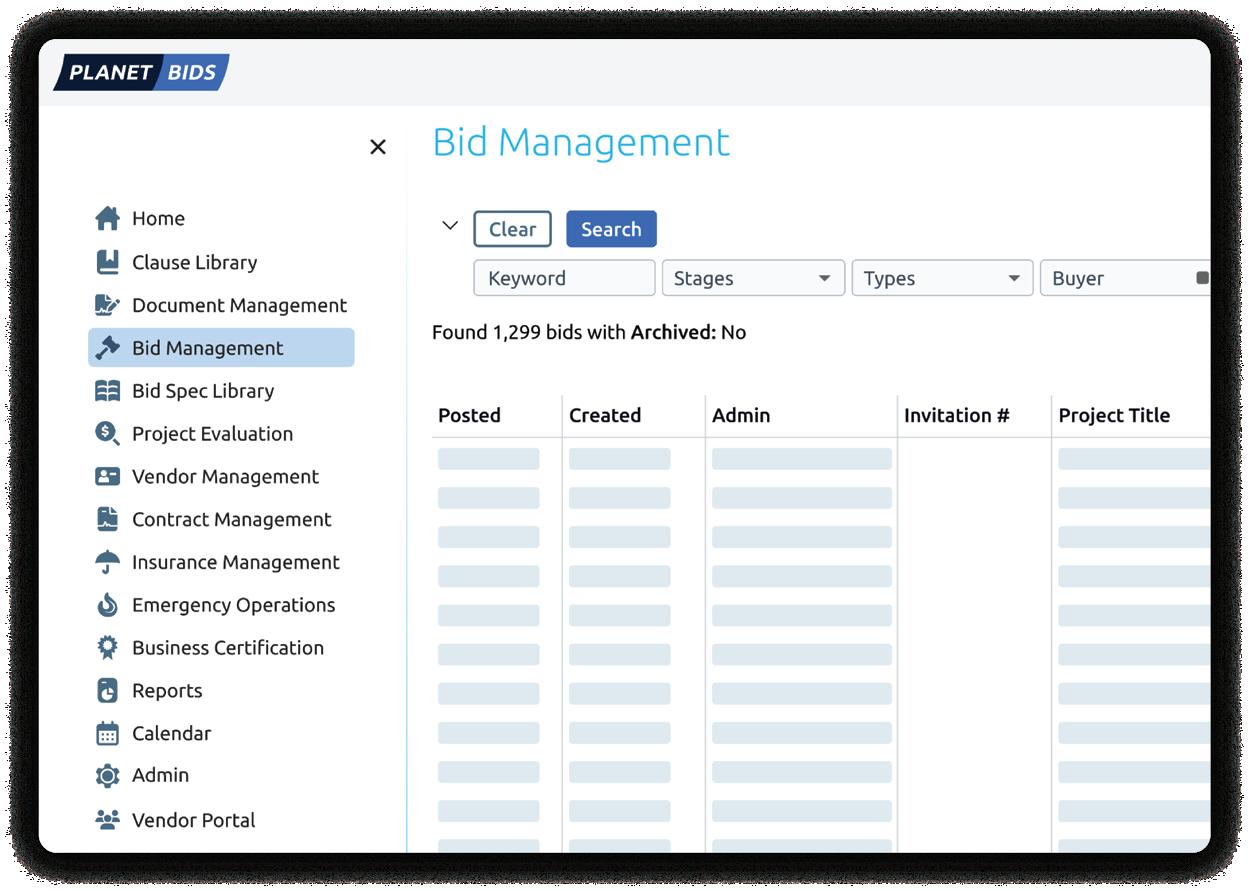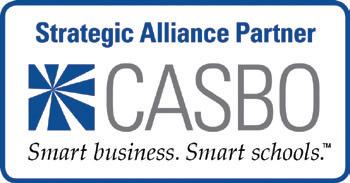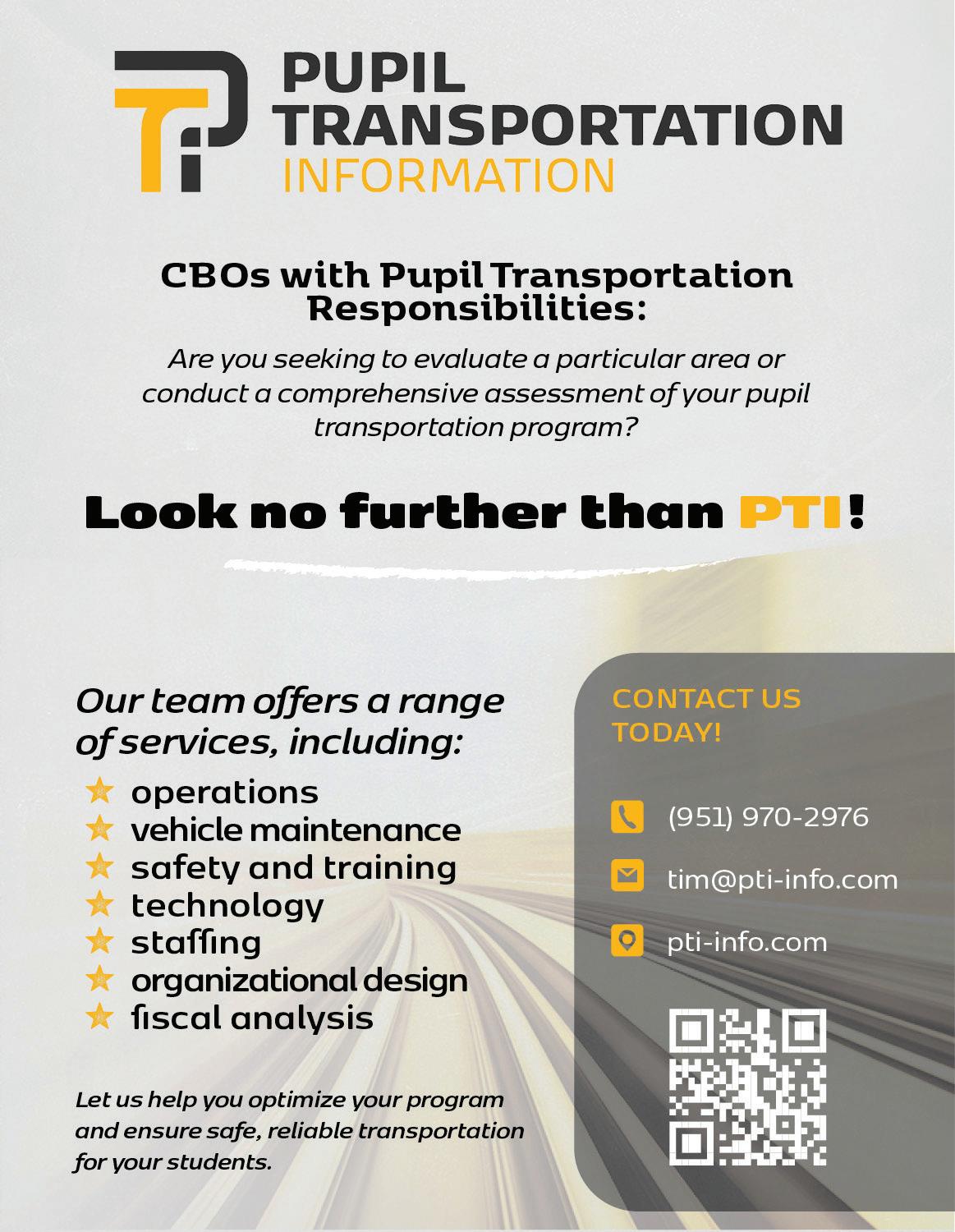
The Real Cost of AB 218
The Law Isn’t Going Away But FCMAT Recommendations Are Designed to Help
Navigating School Closures With Strategy and Sensitivity
Doing Nothing Isn’t an Option. What Is?







The Law Isn’t Going Away But FCMAT Recommendations Are Designed to Help
Doing Nothing Isn’t an Option. What Is?








Today’s students are tomorrow’s leaders. Exactly why Blach Construction is proud to partner with California’s educators to deliver state-of-the-art facilities where learners of all ages thrive.
Whether you’re looking to modernize existing spaces or create all-new learning environments, look to Blach. Together, we will build futures – for everyone.
Trust your next education project to Blach Construction.






Negotiation



The California Association of School Business Officials is the premier resource for professional development in all aspects of school business. Founded in 1928, CASBO serves more than 30,000 members by providing certifications and training, promoting business best practices, and creating opportunities for professional collaboration. CASBO members represent every facet of school business management and operations. The association offers public school leaders an entire career’s worth of growth opportunities.
As the recognized authority in California school business, CASBO is a member-driven association that promotes ethical values; develops exceptional leaders; advocates for, and supports the needs of, members; and sets the standard for excellence through top-quality professional development and mentorship, meaningful collaboration and communication, and unparalleled innovation.
For the past 16 years, CASBO has been dedicated to the organizational planning discipline as a method for guiding the association into a successful future. Last year, the association completed its sixth such plan, CASBO by Design 2.0, a living, breathing document that guided the association in its long-term planning process, which is grassroots in nature, invigorating in procedure and motivating in outcome. Work on our next strategic plan began in 2021.
CASBO has long been committed to organizational planning because the approach has consistently helped the association envision its future and determine the clear steps to get there. The road map that strategic planning provides has allowed CASBO to remain focused on its unique mission, goals and objectives and to respond effectively to a continually changing environment.
For more information on CASBO by Design, visit casbo.org > CASBO + You > About > CASBO By Design.
Stay connected casbo.org
Publisher Tatia Davenport
Features editor
Julie Phillips Randles
Contributors
Jennifer Fink
Jennifer Snelling
Art director Sharon Adlis
Ad production
Tracy Brown
Advertising sales manager Cici Trino
Association Outsource Services, Inc. P.O. Box 39 Fair Oaks, CA 95628 (916) 961-9999
Published March 2025
CASBO OFFICERS
President
Eric Dill
Poway Unified School District
President-elect
Aaron Heinz
Colusa County Office of Education
Vice president
Katie Hylton
San Bernardino County Superintendent of Schools
Immediate past president
Tina Douglas
San Dieguito Union High School District

















Your annual enrollment doesn’t have to take so much time.

Customized Enrollment Communication

Employee Benefits Education
Benefits Admin System


Guided



You spend a lot of time preparing for and executing your annual benefits enrollment. American Fidelity brings representatives to your organization to handle all aspects of your enrollment. We’ll service your entire open enrollment at no additional cost*, and we’ll be there year-round for new hires and life status changes.
We can help! Contact me today.
*Provided at no additional cost as permitted by law. nancy.damuro-olszeski@americanfidelity.com 800-365-9180







CVT


Our public education system, vast and complex, resembles a finely tuned machine where every piece must work seamlessly with the others. Yet, it’s precisely this interconnectedness that makes it fragile. Parts of the system, when misaligned, can create conflicts that ripple throughout our communities.
Take school closures, for instance. Declining enrollments lead to tough decisions – decisions that aren't just about numbers but about the future of our students and the hearts of our communities. These are moments where negotiation and conflict resolution skills aren't just handy; they're essential.


Navigating these challenges requires more than technical expertise; it demands a mastery of negotiation, an often-overlooked skill that extends beyond formal bargaining to influence many aspects of school management and community engagement. In this issue, we explore how honing these abilities can make all the difference in steering our education system through its most fragile points.
As CEO of CASBO, I’m proud of the deep knowledge we have cultivated about our education system. Our aim is to continue this tradition, keeping our eyes and ears open to not only what’s happening within education but also to any external factors that might present both threats and opportunities. It’s about strengthening our ability to manage and lead through robust relationships, data-driven insights and a broad skill set that goes beyond just negotiation and conflict resolution.
This holistic approach ensures we are prepared to support and enhance the resilience and effectiveness of our education system for all involved. z z z
Tatia Davenport CEO


California’s schools serve one of the most diverse student populations in the nation, and it’s essential that the professionals supporting our schools reflect that diversity. With that in mind, CASBO is redefining what it means to be a leader in school business by ensuring that anyone with the passion and dedication to serve can succeed – regardless of where they started.
Not everyone who excels in school business leadership has a formal degree in finance, business administration or education. Some professionals build expertise through years of hands-on experience, working in various departments within a school district.
What unites us is a commitment to serving schools and students.
I have long recognized that talent, dedication and leadership potential aren’t defined by a diploma or job title. That’s why I am proud of the certification programs, workshops and leadership training CASBO offers, which focus on building real-world skills. These programs provide a pathway for professionals to gain the knowledge and credentials needed to advance – even if they don’t have a traditional background in school business.
One of the most valuable things I learned in my journey is that career growth isn’t just about acquiring new skills – it’s also about who you know. Leadership isn’t something you achieve alone. It comes from mentorship, collaboration and shared knowledge.
Through CASBO, I connected with professionals who had been in my shoes. They had faced the same challenges, navigated the same learning curves and ultimately found success in school business leadership. Their guidance, encouragement and willingness to share their experiences helped me understand that my nontraditional background wasn’t a barrier – it was an asset. CASBO provided me with the support system and network I needed to grow.
CASBO’s commitment to professional growth goes beyond individual career advancement – it’s about creating a more equitable and diverse leadership landscape. California’s public schools deserve leaders who understand the unique needs of the communities they serve. That means ensuring equal access to career development opportunities for all school business professionals, regardless of their background.
Through its focus on education, mentorship, networking and advocacy, CASBO is empowering the next generation of school business leaders. The association doesn’t just prepare its members for the next step in their careers – it ensures that the path to leadership is open to all.
For those looking to grow in school business, CASBO isn’t just an organization – it’s an equalizer, an advocate and a lifelong partner in professional success. It certainly has been for me. z z z

Eric Dill President




By Amy Gallo
Let’s get something out on the table: Workplace conflict is a normal, inevitable part of interacting with other people.
If you’re involved in conflicts at work, it’s not that there’s something wrong with you, or the other person. In fact, there’s no such thing as a conflict-free office. We disagree about whether and how to implement a new IT system. We battle over which strategic initiative to pursue. We engage in turf wars about who gets to lead a high-profile artificial intelligence (AI) project. And sometimes, we just act like passive-aggressive jerks
toward one another. As uncomfortable and draining as it can be, conflict is something we all face. It’s how we handle it that matters.
Whether you’re deep in a disagreement with a colleague at this very moment or resolving conflicts is just a skill you want to get better at, I’m here to help. In this article, I’ll explain what conflict resolution is, why it’s an essential skill and how to approach the conflictresolution process. I’ll also share a few principles that are helpful to keep in mind as you navigate any disagreement.
At its very basic, conflict resolution is the process of addressing disagreements with the parties involved by finding mutually acceptable solutions. A productive process will likely include a focus on mutual benefit (what you both stand to gain), active listening from all parties, open communication and some negotiation.
The “resolution” part isn’t necessarily a hard-and-fast agreement on next steps. (Though that is helpful!) There are other
less-tangible aspects that have benefits. For example, engaging in the process may result in a better mutual understanding (“Ah, now I get where you’re coming from”), less tension, increased collaboration and healthier, more resilient relationships.
Of course, the details of each specific resolution will vary depending on the type of conflict you’re having. That said, in my book HBR Guide to Dealing with Conflict, I define a resolution as having three components:
• Your agreement should meet as many of your and your counterpart’s interests as possible. This focus on interests is something that the Program on Negotiation (PON) at Harvard Law School strongly encourages in what they call principled negotiations.
• The resolution should also be fair and reasonable. This means that you and the other person both think it’s a reasonable solution and you could defend it to anyone else who cares about the outcome. And you both need to be satisfied that the process you used to reach the agreement was fair.
• The relationship still needs to be intact. In the end, it’s not a successful resolution if you end up hating each other. You want to be able to say that you maintained your relationship or even improved it.
No matter what your job is, where you work and who you work with, there will be conflicts. Researchers at Gartner named employee conflict resolution as a must-have skill for managers this year. They cited their 2023 survey findings that 57% of managers say they are fully responsible for managing and resolving team conflicts. In other words, learning to navigate conflicts is not really a choice in today’s organizations. It’s an imperative.
Conflict avoidance, even if that’s your default conflict style, doesn’t always serve you. As Amy Jen Su, author of The Leader You Want to Be writes:
“Efforts to be ‘nice’ can have pretty significant costs. You create relationships that are neither authentic nor constructive. Your health and self-esteem may suffer, and you signal that you’re a victim. And your organization loses out as you make compromises with the loudest person in the room, lose the diversity of thinking that’s critical for innovation or stop producing the best solutions.”
On the flip side, productively and professionally engaging in conflict has lots of upsides. Here are just a few I shared in my article, “Why We Should Be Disagreeing More at Work:”
• Better work outcomes. When you and your co-workers push one another to continually ask if there’s a better approach, that creative friction is likely to lead to new solutions. There’s rarely a fixed amount of value to be gained in a disagreement. If you and your colleague are arguing about the best way to roll out a new initiative – they want to launch in a single market first and you want to enter several at one time – you’ll be forced to explore the pros and cons of each approach and ideally find the best solutions.
• Opportunities to learn and grow. As uncomfortable as it may feel when someone challenges your ideas, it’s an opportunity to learn. By listening and incorporating feedback, you gain experience, try new things and evolve as a manager. When a peer chews you out after an important presentation because you didn’t give her team credit for their work, the words may sting, but you’re more likely to think through everyone’s perspectives before preparing your next talk.
• Improved relationships. By working through conflict together, you’ll feel closer to the people around you and gain
a better understanding of what matters to them and how they prefer to work. You’ll also set an important precedent: That it’s possible to have “good” fights and then move on.
• Higher job satisfaction. A study of American and Chinese employees in multinational organizations in China showed a correlation between the use of certain approaches to conflict management – ones in which employees pursue a win-win situation, care for others and focus on common interests –and an employee’s happiness at work.
• Psychological safety. We want to work on and lead teams where people openly share their unique perspectives, debate about ideas and solutions, and communicate with a tone of respect that builds trust. Research shows that teams that share diverse opinions make better decisions. Teams where people feel safe to disagree actually outperform other teams. Psychological safety builds stronger commitment, engagement and accountability to produce results.
When a conflict with a co-worker comes up – a rude email shows up in your inbox or your co-worker raises their voice at you during a meeting – it’s tempting to respond right away.
But when we immediately launch into resolving a conflict, even if we have good intentions, it doesn’t always go well. It’s far better to think through the best way to respond, rather than reacting.
Side note: This is often easier to do when you’re in a remote environment. Your colleague can’t catch you in the hallway or stop by your desk, forcing the conversation. You can often take your time to prepare, even write up some notes, before you and your colleague get back on Zoom or have a phone call.
However, even if you work in the same location, take some time to prepare before having the conversation.
I recommend taking four steps to determine the best way to approach a conflict:
1. Try to see the situation from the other person’s point of view.
When we’re deep in a disagreement, we can get naturally narcissistic, focusing on ourselves and what we stand to lose or gain. So, think about the other person and try to see the situation from their point of view. What do they care about? What’s causing them to behave the way they are? What do they want?
It’s understandable if you assume the worst at first. Maybe even something like, “Well, Amara is acting this way be-
cause she’s a passive aggressive jerk and has been since the day I’ve known her.” Let that first thought go, and then ask yourself what’s the most generous interpretation here? Maybe Amara is under a lot of pressure from her boss. Maybe she didn’t get any sleep last night because her kid was sick.
This is generous to Amara, of course. But it’s also strategic, because you’re putting yourself in the best frame of mind to have a productive discussion and thinking through what Amara’s interests are so that you can incorporate them into your conversations.
2. Pinpoint what the conflict is really about. Often, when we have a conflict at work, we think it’s personal, about our relationship. But more often than not,

conflicts at work are really about – or at least start with – other things. So, review what’s happened so far: what you’ve said and done, who else has been involved, where the disagreement started and what it’s related to.
It can be helpful to think about these four types of conflict (again from HBR Guide to Dealing with Conflict).
• Task. This is one of the most common sources of conflict and it’s a disagreement over the goal of our work together, what we’re trying to achieve. Take this example: Leaders at a tech company agree that one of their best-performing products needs a new feature, but they can’t agree on how to measure its success. Marketing wants to expand the company’s market share. Finance is focused on improving the business’s






























margins. And the engineers care about integrating the latest technology.
• Process. This is a disagreement over the how, where you don’t align on how to get the work done. Continuing with the example above, marketing is at odds with the engineers because they think they should conduct customer focus groups, while the engineers want to wait until they have an internally approved prototype.
• Status. These are disagreements over who gets to make the call on something, who has the authority or power to make a decision or who deserves credit. In the tech company example, the SVP of engineering and the SVP of new product development disagree over which one of them should lead the group that’s designing the new feature.
• Relationship. Of course, there are relationship conflicts, where one or both people feel disrespected or hurt – snapping at each other in meetings, sending snarky Slack messages. Often, a relationship conflict starts as another type of conflict. For example, the disagreement over when to run the focus groups (a process conflict) could escalate into bickering between the two teams that disrupts a broader initiative meeting.
Rarely do conflicts fall into just one of these categories. More often, there are multiple things going on, and many conflicts, no matter where they started, end up as relationship conflicts.
But if you can understand what the conflict is really about, it will be far easier to start to resolve it. So, ask yourself: Are you disagreeing about the goal of a project or how to achieve it? Does your counterpart think they should be leading the initiative? Have you exchanged barbs? Or all of the above?
3. Determine your primary goal. I’ll admit that my default goal is often to prove that I’m right and the other
person is wrong. But that’s a terrible goal! Instead, think about what you truly want from the situation. Do you need to get the project done on time and on budget? Do you want to just end the conversation and move on with your life? Do you need to preserve your relationship with this person because you’ll be working together again in the future?
You may want all of these things, but think about your primary goal. What’s most important? You get bonus points here if your goal overlaps with the other person’s because a common objective is a great place to start to resolve a conflict.
4. Decide how to proceed.
The last step is to decide what to do, based on your work from the first three steps. Many times, simply going through the first three steps will solve the problem. Your attempts to see your counterpart’s perspective may make you realize that the whole thing isn’t such a big deal. Or you may realize you goal is to keep things running smoothly, so you decide to do nothing.
There are other options though. For one, you can choose to let it go. You don’t say anything to your colleague, you let the comment pass, or you move on. We do this all the time, often without realizing it, and for many conflicts, it’s a perfectly good approach. This is a good option when you don’t have the energy or time to deal with the situation, or you suspect the other person is unwilling to have a constructive conversation. But only choose this option if you’re sure you won’t stew about the situation. That’s not actually letting go!
Another option – and the one I recommend most often – is to address the conflict directly. This is where you have a productive discussion about what’s happening and how to resolve it. This is a smart approach if you’re con-
cerned there will be lingering resentment if you don’t address things, or if you want to get your relationship with the other person back on track. It’s also useful if you’ve tried to let it go but the problem persists.
There’s no set script for having the conversation. However, I will point out that choosing your words deliberately during that discussion is important. It’s possible to say the “right” thing that will signal to your counterpart that you’re interested in collaborating and set you on the path toward a successful resolution. Or you might say something that sets your colleague off and derails the process.
You’ll be more effective in putting these conflict resolution strategies into action if you keep a few important principles in mind.
Your perspective is just one perspective. It’s easy to fixate on how you’re seeing the situation and believe it’s objectively “right” or even “just.” This is a normal human thing to do. But just as you have your viewpoint on the situation, so does the other person and they may be equally convinced they’re right. It’s far better to acknowledge that you likely see the conflict differently and that’s OK. You and your colleague won’t always see eye to eye and instead of trying to convince one another, try to rally around finding a path forward. I love the way that Dan Harris, host of the “10% Happier” podcast, describes this principle: Don’t side with yourself.
Don’t just listen. Actively listen. You’ll want to make your perspective heard, but it’s equally important to listen to the other person. If you hear what
they’re saying, you’ll be better positioned to address the right issues – the ones that matter to them and you. This means not only allowing them to talk, but actively listening and demonstrating that you heard what they say and you understand their side.
Don’t make it “me against them.”
You don’t want to get into a tug-of-war with the other person. Instead, imagine that there are three entities in the conflict: you, your colleague and the problem you’re trying to solve. You can use positive, collaborative visualizations, such as you and your co-worker sitting on the same side of a table, instead of combative ones to improve the odds of reaching a resolution.
Experiment to find what works.
As I said earlier, there is no set script for resolving conflicts. Instead, you have to go in with an open mind and a willingness to adjust your approach as you go. Think of yourself as a scientist who is trying to figure out the best way to solve a conflict. Then, keep refreshing your approaches, based on what you learn along the way, and be willing to abandon ones that aren’t producing results. You might try something you haven’t tried before, even something the other person might not expect to help bring the conversation in a new direction.
Regulate your emotions.
It’s hard not to get worked up emotionally when you’re deep in a conflict situation. After all, a disagreement can feel like a threat. You’re afraid you’re going to have to give up something – your point of view, the way you’re used to doing something, the notion that you’re right, or maybe even power – and your body therefore ramps up for a fight by triggering the sympathetic nervous system. You’re not
going to solve the underlying issues if you power through the conversation when you’re in “fight, flight or freeze” mode. Take a deep breath and focus on your body. You might repeat a mantra to yourself such as “This isn’t about me,” “This will pass” or “This is about the business.” Remember to be curious. Adopt a growth mindset – believe that you have something to learn for the situation. And don’t forget the value of taking a break.
Mastering all of these steps will not absolve you from having conflicts at work. But that isn’t the goal. You may on occasion still react in a way that you regret. But by following the advice above, those occasions will be fewer and less painful – for you and your colleagues. z z z
Amy Gallo is a contributing editor at Harvard Business Review, a co-host of the Women at Work podcast, and the author of Getting Along: How to Work with Anyone (Even Difficult People) (Harvard Business Review Press, 2022) and the HBR Guide to Dealing with Conflict (Harvard Business Review Press, 2017). She writes and speaks about workplace dynamics.
A version of this article appeared in the October 21, 2024 issue of Harvard Business Review. Reprinted with permission.
© 2024 Harvard Business School Publishing Corp.





By Julie Phillips Randles

by
It’s not uncommon for a career path in school business to include some twists and turns, but Elizabeth McClanahan’s trajectory is particularly unique, combining a number of skills and interests that today benefit the 29,000 students of Mt. Diablo Unified School District (MDUSD).
McClanahan, director of purchasing and warehouse at MDUSD, began her career in the culinary world, where her love for science and art led her to pursue a role as a pastry chef. Her career was cut short when she discovered she was allergic to eggs, flour and nuts – and a new pathway was required.
So, when an attorney friend needed support at his San Francisco law office, McClanahan stepped up to the plate. She got the law bug, earned a paralegal certification and worked in boutique law firms for nine years, handling research and eventually serving as second seat in court proceedings.
In 1997, McClanahan began handling the accounting and bookkeeping for the cafe she owned with her husband and, later, a catering company. To upskill, she returned to school to earn a bachelor’s degree in business administration and a minor in accounting. It didn’t take long for her to take on additional accounting clients, while simulta-
neously working as a noon supervisor at her daughters’ school.
When an accounting job in MDUSD’s special education department opened, it was the perfect fit. In the course of 15 years at MDUSD, she moved up through roles in payroll and accounts payable before entering the purchasing world – a place where her expertise in foodservice, accounting, contracts and research all come together.
Today, as the purchasing and warehouse director, McClanahan oversees all purchase orders, manages warehouse deliveries and surpluses, and is responsible for bidding for Mt. Diablo’s 58 campuses that serve PK-adult students across eight cities.
“I enjoy what I do here because I get to play in two worlds I love – accounting and contracts. I joke that I buy everything from pencils to buildings,” McClanahan says. “I also work with the facilities department, which allows me to be involved in building out classrooms for our kids. We can be disconnected from the kids by not being at school sites, but when I’m involved in purchasing for a classroom and I take a field trip to see what I bought in action it’s great!”
And because Mt. Diablo Unified is home to a popular college- and career-ready program, McClanahan has become an expert in a number of vocations. From medical,
engineering and construction trades to automotive and EMT jobs, she supports staff in getting the materials they need to give students hands-on career experiences. That has included some surprising buys, like medical instruments, hazmat suits and even an ambulance chassis.
McClanahan says a lot of the training she needed to be successful in school business came from CASBO. “When I found CASBO, the training drilled into whatever information I needed to do my job at the time. From special education to accounting, I could get all the details.” And that’s why she’s so keen on volunteering with CASBO. “I had been a sponge in CASBO training, and I wanted to give back and network with others of a like mind.”
Today, McClanahan is the president of CASBO’s Central Bay Section (formerly the Northern Section). She previously served as president elect and director II for the Northern Section, and was the chair of the Accounting Professional Council.
With a resume like hers, McClanahan likely isn’t done learning or giving back.
“As a director, I love being a mentor and teacher to staff in my department or at school sites so I can support others in doing their jobs better.” z z z
On average, Americans spend $13,493 per person on healthcare each year1 .
Wise Benefits is focused on providing exceptional supplemental insurance policies that can help provide benefits for needs medical insurance may not cover. We’ve created packages that may help meet your needs if an unexpected illness or injury happens, including employer-sponsored and individual voluntary options.
For more information, visit wisebenefits.com.
Wise and Wise Benefits are trademarks of Horace Mann Educators Corporation






John Baracy Managing Director
California K-12 Market Lead 310-492-8110 rwbaird.com/californiak12
Alex Boutyrski
Anne Mongoven
Claire Peterchak
By Jennifer Snelling

When Craig McAlpin became a chief business official (CBO) in Colusa County in 2007, he jumped in with both feet, despite having no experience with school finance. He jokes that as a CBO for a small district, every day is “all hands on deck,” regardless of what your title is or what department you work in.
On a typical day, one minute he would be working on the budget, and the next minute he would be putting on plastic gloves to help serve hot dogs in the cafeteria.
The experience prepared him well for the job he has now, director of client services at MGT Consulting, a CASBO Premier Partner. MGT Consulting (formerly Eric Hall and Associates) provides customized solutions for school districts and county offices in facilities, fiscal and budget, human resources, technology, geographic information systems (GIS) and other services to help solve problems and provide solutions.
McAlpin’s role is to assist districts that need someone to provide staff augmentation, finding solutions and solving problems for school districts. He facilitates mentoring for new CBOs, purchasing directors, payroll and budget staff, and other school business professional services. He also provides
support to districts with school closure and consolidation, budget stabilization, technology training and more.
“The associates on our team have extensive school district experience, whether in fiscal, HR, facilities, payroll or purchasing. We are school people helping school people,” he says.
“What I absolutely love about being part of the MGT team is that we get to help districts solve problems and achieve success,” he says. “It’s rewarding because we are truly giving back to communities and, so often, schools and school districts are the centerpiece of the community.”
Since becoming a CBO in 2007, McAlpin has relied on CASBO for its expertise and was honored when he was selected to serve on CASBO’s Associate Member Committee in 2022.
“CASBO and its team are truly the go-to for all issues in the school business market in California – a resource that is relied on by so many during both the good and challenging fiscal times we all will experience.”
McAlpin started his career in the private sector, working in accounting and the golf industry. After working in Colusa County for many years, he moved to Southern California
and has worked at the Riverside County Office of Education as a district fiscal services coordinator, at Anaheim Elementary School District as the director of administrative services, and was most recently the CBO at Banning Unified School District.
When not working, he enjoys golfing, snowboarding, traveling and, most importantly, spending time with his wife, five kids and extended family. z z z
Presenting the all-new Volunteer Rewards Store, where members can redeem points earned through completing volunteer opportunities for exclusive branded CASBO gear.
Choose from 30 travel, tech, and office items ranging from 5 to 60 points. From chargers and tumblers to apparel and more, there’s something for every busy school business professional on the go.
Scan the QR code to log into your member account and start shopping the 2024-25 product catalog today!

2025 CALIFORNIA ASSOCIATION OF SCHOOL BUSINESS OFFICIALS (CASBO). ALL RIGHTS RESERVED.

No points? No problem! Start earning on Volunteer Hub, our member portal to search and sign up for 300+ positions fitting all career stages and school business disciplines. Scan QR code to get started today.




Organizational Subscription members, post FREE job openings on our LEA Job Lising page! Fill your agency’s open roles faster by connecting with 300+ CASBO Student Members actively seeking positions in school business upon college graduation.
Taking advantage of this new benefit included in all 2024-25 Organizational Subscription memberships is as easy. Simply:
1. Scan QR code below or go to https://casbo.info/job-listings
2. Enter your agency’s information.
3. Submit the completed form.
Maximize your Organizational Subscription benefits by submitting your job listing today! For questions or assistance, contact CASBO Member Services at membership@casbo.org or call +1 (916) 447-3783.

The foremost authority in school business
As a Third-Party Administrator (TPA), SchoolsFirst Plan Administration expertly manages the day-to-day responsibilities of California school employee retirement plans.
• We process your employee contributions securely with a remittance turnaround of 24 hours — fastest in the industry.
• As a local and not-for-profit organization, we’re committed to delivering personalized service to you at all times.
• We provide complimentary financial education through workshops, programs, articles and consultations.
We ensure a smooth transition by managing the entire process from start to finish.
CALL (800) 462-8328, ext. 4727
EMAIL rpa@schoolsfirstfcu.org
VISIT schoolsfirstfcu.org/tpa




by Corey Wilson

By Julie Phillips Randles
Kwame Christian’s life philosophy is summed up in one easy-to-understand motto: “The best things in life are on the other side of difficult conversations.”
And, of course, as a negotiation expert and founder and CEO of the American Negotiation Institute, he wrote the book on it, Finding Confidence in Conflict: How to Negotiate Anything and Live Your Best Life.
But while it’s a graspable concept, actually initiating and navigating a difficult conversation is where many people pull up short and stop before they ever try.
Christian wasn’t really afforded that luxury. The grandson of a man handpicked by the prime minister to be the first Permanent Secretary of Guyana, Christian grew up influenced by a man who conducted diplomatic missions
to more than 30 countries and led the Guyanese military. Before his grandfather passed, Christian had the opportunity to ask for a favor.
“Granddad, you are 99-years old, and Kai and Dominic [Christian’s children] are 8 and 2. What life advice do you have for them?”
The answer wasn’t technical. It wasn’t a how-to list of steps. But it cut right into the heart of humanity: Live in harmony and look to older generations for wisdom. Stay humble because you are not perfect. Forgive because no one is perfect. There will always be flaws. Let that humility guide you.
And in that heartfelt advice, Christian held the key ingredient in learning to step out and have a difficult conversa-
tion. “The persuasive power of humility in leadership lies in its ability to disarm, engender respect and facilitate collaboration,” he wrote in Forbes. “Focusing on others rather than oneself, leaders can motivate their teams, drive innovation and navigate complexities with grace and resilience.”
These are leadership vibes he now shares on his podcast, “Negotiate Anything,” which is currently the No. 1 negotiation podcast in the world. He’s also written How to Have Difficult Conversations About Race: Practical Tools for Necessary Change in the Workplace and Beyond, a topic very much in conversations in 2025. The book has a 4.8-star rating (practically perfect in Amazon speak), with readers finding the book relatable.
“… He upped the game by taking a potentially controversial (and needed) topic and making it relatable. In my opinion, one of the best books that I’ve read on this topic (if not the best),” said one reviewer. Also, “[It] takes a heavy and important topic and makes it approachable for anyone in any role.”
“Get ready to use your highlighting feature on Kindle,“ says another.

CASBO reached out to Christian to discuss these highlightable topics as they relate to the challenges school leaders confront.
What’s something you thought you knew that you found out you were wrong about?
In law school, I was trained to build the strongest logical arguments – to be right, to back up my points with evidence and to present airtight reasoning. I thought that if I simply laid out the best case, people would have no choice but to agree. But in the real world, I quickly learned that there’s a difference between being right and being persuasive.
Negotiation isn’t about presenting a case to a judge who is bound by law to rule based on logic. It’s about influencing people – who are driven by emotions, biases and personal interests – to willingly choose to work with you. If someone doesn’t feel heard, validated or emotionally engaged, no amount of logic will convince them to move in your direction.
That realization was a game changer for me. It led to the development of my Compassionate Curiosity Framework, which is built on the understanding that people don’t make decisions based purely on facts. They make decisions based on how they feel about those facts.
If you can acknowledge emotions, ask the right questions and create solutions that align with their interests, you don’t just win arguments – you actually get people to say “yes.”
What’s the best advice you’ve ever received? From whom?
The best advice I ever received was from one of my mentors who told me, “There’s a difference between being liked and being respected.”
I was a people-pleaser by nature, always trying to keep the peace and
avoid conflict. But I realized that if I wanted to have the impact I aspired to, I had to be willing to engage in difficult conversations, set boundaries and stand firm when necessary. Being respected means that people may not always agree with you, but they trust your decisions and understand where you stand. That shift in mindset allowed me to grow into a stronger leader, negotiator and communicator.
What are your key tips for resolving conflicts through negotiation without escalating tensions?
Conflict resolution is all about balancing empathy and strategy. My Compassionate Curiosity Framework provides a simple but effective three-step approach to navigating difficult conversations without increasing tension:
1. Acknowledge emotions. Before jumping into solutions, recognize and validate the other person’s emotions. This doesn’t mean agreeing with them but showing that you understand how they feel.
2. Get curious with compassion. Ask open-ended questions to uncover deeper interests and concerns. People are more willing to collaborate when they feel understood.
3. Joint problem-solving.
Shift from a “me vs. you” dynamic to a “we vs. the problem” approach. Work together to find creative solutions that meet mutual needs.
By following these steps, you transform conflict from a battle into a collaborative conversation.
What are some strategies to help school district leaders negotiate contracts and agreements that maximize value when financial resources are limited?
For school district leaders, negotiations often happen under tight budget con-
straints, requiring a blend of tactical strategy and assertiveness. Here are some pro tips:
• Leverage nonmonetary value. Instead of focusing only on price, negotiate for additional services, extended warranties or professional development for staff.
• Seek multi-year agreements. Many vendors offer better terms for long-term contracts, creating stability and cost savings over time.
• Use cooperative purchasing. Partnering with other districts can increase purchasing power and lead to better deals.
• Negotiate performance-based contracts.
Ensure that payments are tied to deliverables to maximize accountability and results. Approaching negotiations with creativity ensures that districts make the most of every dollar.
What are the most crucial negotiation skills to effectively manage school district resources?
Managing school district resources requires a combination of listening, curiosity and emotional management. Here’s what that looks like:
• Listening
Active listening allows you to gather critical information, understand stakeholders’ needs and identify underlying interests that may not be immediately obvious.
• Curiosity
Negotiation is problem-solving, and curiosity is the key to unlocking creative solutions. Ask the right questions to explore alternatives and maximize value.
• Emotional management
High-stakes negotiations often come with pressure, emotions and competing interests. The ability to stay calm, composed and strategic in tough con-
Being respected means that people may not always agree with you, but they trust your decisions and understand where you stand.
Success in negotiation isn’t just about knowing what stakeholders want – it’s about showing them that you care.
versations is crucial for long-term success.
Can you share a few techniques for balancing and aligning the interests of diverse stakeholders, particularly in complex settings like school districts?
Success in negotiation isn’t just about knowing what stakeholders want – it’s about showing them that you care. Personal conversations build trust. With this in mind, you should:
• Find shared interests.
Even if priorities differ, start with common ground (e.g., improving student outcomes).
• Engage stakeholders early. Pre-meeting discussions allow you to align expectations before formal negotiations.
• Use a transparent decision-making process.
When stakeholders feel included, they’re more likely to support the final agreement. Building relationships before negotiations makes reaching agreements easier when it matters most.
What do negotiation tactics for various situations have in common?
For instance, negotiating with a teachers’ union versus negotiating an issue with a family member? The fundamentals of human psychology remain the same across all negotiations. But the context, culture and complexity vary significantly between personal and business negotiations, requiring adjustments.
• Context
A business negotiation involves policies, contracts and financial impact, while a personal negotiation involves emotions, relationships and shared experiences. For example: Asking your boss for a raise requires data, timing and positioning. Asking your spouse to move cities
requires emotional buy-in and shared vision.
• Culture
Workplace culture is formal, hierarchical and often cautious, whereas personal relationships involve greater emotional openness and risk. For example: A direct approach may work in business but could feel harsh in a personal setting.
• Complexity
Business negotiations often involve multiple stakeholders, layers of approval and financial constraints, while personal negotiations involve fewer people but deeper emotions. For example: A school district budget negotiation has long-term financial consequences and legal implications. A conversation with a family member about finances is emotionally charged but legally simple. Success in both requires adaptability – adjusting your tone, timing and approach based on the situation.
What are three tips for making difficult conversations easier?
1. Prepare with purpose. Know your message and your desired outcome to stay focused.
2. Lead with empathy.
Acknowledge emotions to reduce defensiveness.
3. Clarify intentions.
Set a collaborative tone by explaining your goal up front.
With the right mindset, difficult conversations become opportunities for growth.
What factors define a successful negotiation?
A negotiation is successful if it achieves three goals:
1. Offense
Getting more of what you want. Did you secure additional funding, better contract terms or a strategic advantage?
2. Defense
Avoiding what you don’t want. Did you protect against unfavorable terms, hidden costs or risky commitments?
3. Relationship
Maintaining or strengthening connections. Did you negotiate in a way that builds trust and long-term partnerships?
Ultimately, the goal is to be effective and ethical – leveraging a broad skill set to adapt to different circumstances while achieving your objectives. There’s no single path to success, but the best negotiators know how to blend strategy, flexibility and relationship management to get the best possible outcome.
Remember, negotiation is more than a skill – it’s a mindset. Whether navigating contracts in a school district or managing personal relationships, the key is to balance strategic thinking with empathy. Master that, and you’ll not only win more negotiations – you’ll strengthen relationships and create lasting impact. z z z
Julie Phillips Randles is a freelance writer based in California.
Remember, negotiation is more than a skill – it’s a mindset.






















Procurement is no longer just about purchasing. It has evolved into a strategic function that ensures efficiency, compliance and innovation. With the rise of artificial intelligence (AI), sustainability initiatives and data-driven decisionmaking, procurement professionals must stay ahead of the curve. The key to success is in adopting the right tools and strategies that simplify workflows and optimize procurement operations.
The integration of artificial intelligence is transforming procurement by automating processes, reducing errors and enhancing decision-making. Imagine a system that can analyze supplier performance in real time, forecast demand with pinpoint accuracy and eliminate the tedious manual tasks that slow down operations.
AI-powered analytics provide procurement teams with deeper insights, allowing them to make more informed choices and optimize spending. Agencies that leverage automation in bid evaluations, supplier onboarding and contract management free up valuable time and resources so they can make more strategic procurement decisions.
Today’s procurement strategies must align with sustainability goals. Public agencies are under increasing pressure to partner with environmentally responsible suppliers and integrate ethical sourcing practices. Sustainable procurement reduces waste, improves operational efficiency and even leads to long-term cost savings.
Compliance with evolving environmental regulations is another crucial factor, as failure to adhere to these standards can result in legal and

reputational risks. By carefully selecting vendors that meet sustainability criteria, procurement teams can ensure a positive impact while maintaining efficiency.
The days of transactional supplier relationships are fading. Successful procurement teams focus on building long-term partnerships with vendors that offer innovation and reliability. A strong vendor relationship fosters collaboration, ensuring that suppliers consistently meet quality expectations and contribute to mutual success.
When procurement teams communicate openly, conduct regular performance reviews and work alongside suppliers on process improvements, they unlock opportunities for cost savings, efficiency, and innovation that benefit both parties.
Nowadays, data is king, and procurement teams must harness analytics to optimize their strategies. By analyzing past purchasing data, agencies can uncover inefficiencies, spot spending patterns and optimize vendor selection.
With the right tools for good analytics, teams can enhance bid strategies, track supplier performance and mitigate risks before they escalate. Investing in procurement intelligence empowers teams to make proactive, informed decisions that drive efficiency and cost savings.
Agencies that embrace changing technology and best practices will lead the way in providing value. Integrating digital tools, fostering sustainability and strengthening supplier relationships are now essential, and staying ahead means investing in automation, upskilling for your procurement professionals and aligning long-term strategies with broader agency goals.
Ready to lead the way in procurement innovation? Stay ahead of the curve by adopting smart procurement technologies and strategic partnerships. Check out PlanetBids’ State of Procurement White Paper [home.planetbids.com/ state-of-procurement] to explore more emerging trends and actionable insights that will transform your procurement processes. z z z
Courtesy of PlanetBids, a CASBO Premier Partner.























Designed for hybrid classrooms, the HP EliteBook x360 1040 G11 Notebook, powered by Intel® Core™ Ultra 7 processors, delivers:
♦ Powerful performance for multitasking and demanding applications
♦ Advanced connectivity options for seamless integration with devices and networks
♦ Extended battery life for uninterrupted productivity throughout the day
♦ HP Sure Start, Sure Click and Wolf Security to help protect your sensitive data
Plus, keep your students better focused with simpler organization, and effortless navigation of Windows 11 Pro.












School Services of California Inc. (SSC) is the leading provider of consulting, governmental relations, and information services for K-14 educational agencies in California. Since 1975, SSC has been proud to provide services to nearly every educational agency in the state.
• Management Consulting Services
• Governmental Relations Services
• Collective Bargaining and Factfinding Services
• Executive Searches and Recruitment
• State Budget Conferences and IssueSpecific Workshops
• The Fiscal Report and Specialized Publications
Renew your agency’s Organizational Subscription membership and extend the value of your investment with CASBO’s 3-year membership option.
Benefits include:
• Locked-in membership pricing through 2027-28.
• Enjoy continuous access to benefits supporting 15 school business disciplines through June 30, 2028.
• Eliminate renewal reminders and avoid a lapse in benefits for the next three years.
Best of all, you can save up to $800 by paying all three years up front in full.
Hurry, this offer is only available to Organizational Subscription members through June 30, 2025. Scan the QR code at right for more information or to sign up today!


Save up to $800 when you pay all 3 years upfront & renew by June 30!

The
By Jennifer Snelling
At a California middle school in the late 1990s, a teacher repeatedly sexually abused two students. The teacher, who is no longer with the district, had previously faced charges of molesting his foster son. The former students sued the district, arguing in court that the district’s officials knew, or should have known, that the teacher posed a threat to students.
In 2023, a jury issued a $135 million verdict in favor of the former students. The jury required the district to pay 90% of the judgment, and the abuser, who is in state prison on child molestation charges, was ordered to pay 10%.
The district negotiated the price down to $45 million. The Schools Excess Liability Fund (SELF) covered $15 million, leaving the district to pay $31 million plus legal fees from its reserves.
“The jury recognized the severe and profound effect that this long-term abuse had,” Brian Parish, a lawyer representing one of the former students, told the Los Angeles Times. “This is totally preventable, 100%. It should have never happened.”
The teacher was with the district for two decades and the district faces four additional lawsuits.
“The … district deeply regrets what happened to these individuals. Although it happened under a previous administration over 27 years ago, the district understands the lifelong impact of these traumatic experiences,” the district said in a statement to the Los Angeles Times
Lawsuits like this one are possible because of AB 218, The Child Victim’s Act, a bill passed in 2019 that extends the statute of limitations for the filing of abuse charges against school districts. The bill allows survivors of childhood sexual abuse to file civil lawsuits against schools until age 40, instead of the previous age of 26, and up to five years from the date of discovery of the link between their abuse and psychological harm.
In addition, AB 452 further changed the statute of limitations on childhood sexual assault, eliminating the statute of
limitations on recovery of civil damages suffered because of childhood sexual assault for claims that arise on or after January 2024.
The law also requires local education agencies (LEAs) to implement reasonable safeguards to avoid acts of childhood sexual assault when district employees are on notice or had reason to know of such a risk. If a victim proves their assault was part of a cover up, the victim may receive triple the amount of compensatory damages.
It’s difficult to assess exactly what these claims are costing schools until each claim is decided, but the impact is significant. According to CASBO data, “the statewide total that has been assessed from just one risk pool to self-insure claims that are now allowed under AB 218 is $261,407,688. The assessment alone for the 2024-25 school year is $134,553,212 million. This is roughly equal to $27 per ADA, when the average COLA for districts is $113 per ADA.”
This means an estimated 25 cents of every new Local Control Funding For-
”At this time, we are advising all members to regard these assessments as an annual expense within your multiyear projections.”
mula (LCFF) dollar for K-12 education in 2024-25 was used for past claims. That’s the equivalent of 25% of a 1% COLA, or 52 teachers in a district and funding for 417 students.
The SELF annual report found that there was a 25% increase in the number of claims between June of 2023 and October of 2024. California ranks in the top 10 states for generating nuclear verdicts, a jury award in a civil lawsuit that is significantly larger than what is considered reasonable or expected.
The SELF report adds, “At this time, we are advising all members to regard these assessments as an annual expense within your multi-year projections.”
The issue is a complex one that struggles to balance the rights of sex-
ual abuse survivors with the rights of children currently in a chronically underfunded education system led by people, in most cases, entirely different from those who perpetrated the abuse.
“It’s extremely important to validate and honor the intent of the bill, which is that victims of abusive acts deserve justice and compensation,” says Kevin Gordon, president and partner of Capitol Advisors Group, and a former CASBO executive director. “The problem with the bill is that it accomplishes that goal on the back of today’s kids. It is tantamount to reoffending children today for sins of adults generations ago who don’t have anything to do with our public schools now. As we try to serve children

across the state today, the notion of taking hundreds of millions of dollars away from their education seems to be a horrible way to solve this problem.”
While most people want victims to see justice, the consequences for LEAs, and consequently for today’s students, are very real.
“It is like changing the goalposts now that you can go back in time. It’s absolutely a reputational hit for the organization. Victims deserve justice, but it is going to impact the resources we have to provide the high-quality instruction we are supposed to provide,” says Mark Schiel, chief business official for Santa Clara Unified School District, speaking as chair of CASBO’s Legislative Committee.
Even when the people who were alleged to have committed the act are no longer at the district, the allegations erode trust between schools and their communities. But it’s the financial cost that is catastrophic.
While districts have insurance or are part of an insurance pool, the judgments have become so large that insurance policies or pools don’t cover all of it. In other cases, the incident happened so long ago that the districts don’t even know who was providing coverage at the time of the incident. Or the company providing coverage is now defunct, or the district has left the pool they participated in at the time of the incident.
Even if that information can be tracked down, if the insurance pool closed, they may have distributed leftover funds back to members as a dividend, not anticipating the change in statute of limitations.
If a district is part of a pool and hasn’t been sued, that doesn’t mean they’re off the hook. They often end up having to

pay out on a suit against another district in the pool.
“The insurance market for public agencies is perilously unstable,” according to a recent report on AB 218 from the Fiscal and Crisis Management Assistance Team (FCMAT). “In the worst case, the market could deteriorate to a point where there is not enough insurance available, and public agencies could end up competing with each other for the limited coverage still being offered.”
Insurance comes from a company or a pool, and premiums have already risen an estimated 700%. In part, because the insurance industry was not prepared for the change in law. The result is that all schools suffer.
“Victims deserve justice, but it is going to impact the resources we have to provide the highquality instruction we are supposed to provide.”
”Because schools must pay judgments or settlements out of their general funds, staffing is impacted, meaning fewer adults are in each classroom to keep kids safe.”
In fact, the law could end up exacerbating the problem of abuse. Because schools must pay judgments or settlements out of their general funds, staffing is impacted, meaning fewer adults are in each classroom to keep kids safe.
In the worst-case scenario, LEAs or school districts could become insolvent, meaning a district can’t meet its payroll
obligations. If a school district requests assistance, the state will loan the district money to make its obligations and the district will pay the state back over 10 to 20 years.
School business professionals cannot be blamed for feeling the best solution

would be for the law to be amended or repealed.
“School folks want the law to go away,” says Michael Fine, CEO of FCMAT. “That’s not going to happen.”
State leaders recognize that the situation is not tenable for schools and districts, and passed SB 153, which charged FCMAT with developing recommendations.
The report, “Childhood Sexual Assault: Fiscal Implications for California Public Agencies,” makes 22 recommendations based on the following themes:
1. Mandated childhood sexual assault claim reporting, statewide data repository and data classification. Currently, there is no database on sexual assault outcomes, making it
hard to know precisely how these cases are impacting California. FCMAT’s first recommendation is to require the development and maintenance of a statewide data repository, mandating information sharing by public agencies.
2. Amended timelines for public agencies to pay a judgment to facilitate public financing of all or part of a judgment.
Amending Government Code 970.6 to allow a sliding scale of time for repayment based on the judgment amount. This would allow districts to extend the maximum repayment term of 20 years when the loan amount is significantly higher than the school district’s ability to pay.

F3 Law has a passion for education, and our mission is simple—to support educators in achieving their mission. We do this by offering distinctive legal services and keeping educators informed on every issue they face, so they can focus on achieving positive student outcomes.
• Business, Facilities & Construction
• Education Technology
“Currently, there is no database on sexual assault outcomes, making it hard to know precisely how these cases are impacting California.”

”The goal should be to completely eliminate childhood sexual assault in local public agencies.”
3. Enhanced provisions related to the public financing of obligations. Extend state and local payment mechanisms to public financing by local public agencies rather than limit the mechanism to the California School Finance Authority. One example is the California Infrastructure and Economic Development Bank, which offers public agency revenue bonds.
4. Alternative statutory provisions for emergency apportionments for school districts.
Typically, when a school district can’t meet its payroll obligations, it will request a loan from the state. When that happens, the school goes into a receivership with the state, which comes with many requirements, including personnel placed within the district.
For receiverships that are due to litigation rather than fiscal mismanagement, FCMAT recommends districts receive a loan with less intervention from the state.
5. Study and establish a victims’ compensations fund options.
FCMAT recommends the state create a victims’ compensation fund similar to the one created for victims of the September 11, 2001, terrorist attacks. This would allow victims to be compensated outside of a judicial setting and potentially allow the state to share the financial cost.
This study should be presented to the Legislature no later than January 1, 2026, and the Legislature should consider establishing a victims’ compensation fund by July 1, 2026.
6. Consistent and expanded statutes focused on preventative measures. The intention behind AB 218 is to prevent future cases of sexual abuse from happening in schools. To that end,
FCMAT recommends comprehensive school safety plans with improved supervision and protection of children, as well as increase the quality and consistency of mandated training to prevent childhood sexual assault, and mandate training of students to promote awareness and help provide protection.
“The goal should be to completely eliminate childhood sexual assault in local public agencies. One of the frequent criticisms of AB 218 and AB 452 is that neither bill promoted a state policy priority of eliminating childhood sexual assault offenses, and neither addressed the topic of prevention,” reports FCMAT. “Preventive measures and mandates must be increased to protect children.” z z z
Jennifer Snelling is a freelance writer based in Eugene, Oregon
How is your district dealing with AB 218 challenges? Let us know at LinkedIn/CASBO.






Doing Nothing Isn’t an Option. What Is?
By Jennifer Fink
It’s a problem no one wants to talk about.
Student enrollment is down throughout California and projected to decline even more. The number of students enrolled in K-12 public school has dropped by more than 460,000 students over the past two decades, and the California Department of Finance expects there will be just over 5 million students in state public schools by 2032, compared to 6.3 million in 2006-2007.
Mathematically speaking, it’s a simple problem: Fewer students require less space and fewer resources. But navigating the reality of declining school enrollment is never that simple. Schools are often the heart of a community. That’s why proposals to close and consolidate schools often meet fierce community resistance. Although most people realize that it doesn’t make good economic sense to educate 200 children in a building designed for 1,000 students, few people want their school to close.
The political, emotional and logistical challenges of school closures are one big reason why most school business leaders would prefer to “go their whole careers without ever having to touch this issue,” says Jason Willis, a senior policy advisor with WestEd, a nonpartisan research, development and service agency.
Fewer people are moving into the state, and some communities have been particularly hard hit.
But ignoring steadily declining enrollment isn’t a smart idea either. To uphold their commitments to students and families, school business officers, superintendents and school board members must work with the community to determine how to most effectively use available resources.
Birth rates are (and have been) down. There are simply fewer children today than in years past, and virtually no reason to expect a quick uptick in birth rates. In fact, experts predict a continued decline over the next decade or so.
Additionally, California continues to lose population as residents struggle with high housing costs and taxes. Fewer people are moving into the state, and
some communities have been particularly hard hit. According to a report by Cal Matters, San Francisco, Oakland, Los Angeles, San Jose and San Diego “have all experienced steep declines in enrollment.” Many students and families have moved out of these pricey areas; others have opted for private or home education.
Fewer students means less state funding, as average daily attendance is used to calculate how much funding schools receive. However, unique provisions in California state law have cushioned the impact of declining enrollment in some districts. Because the Local Control Funding Formula (LCFF) directs additional resources to districts with a high proportion of high-needs students, some schools have been able to maintain operations despite steep decreases in enrollment.

“Since LCFF was implemented, per pupil spending has increased dramatically. We’re spending more than ever before and there is evidence that increase in funding has helped delay school closures,” says Carrie Hahnel, a senior associate partner at Bellwether in the Policy and Evaluation practice area. “National data and analysis show that California has not closed schools commensurate with its enrollment losses, unlike other states, like Colorado.”
The situation is unsustainable. As noted in a 2023 policy brief co-authored by Hahnel, underenrolled schools are simply more expensive to maintain on a per-student basis. Districts that are getting by now will almost surely need to need to make cuts and changes in the years ahead – or watch their reserves steadily drain until difficult facilities decisions become unavoidable.
Small tweaks won’t be sufficient to address the challenges ahead. The traditional approach of trimming around the edges – cutting junior staff positions and non-core programs – is like taking a quarter-inch off your hair every few months when what you really need is a completely new style.
“Some systems are creating circumstances in which they are going to starve themselves from the edges,” Willis says. “Rather than taking a step back and thinking: If we are going to lose 20% of our students, what does that mean for the way we hire personnel? For the way we organize teams of adults who are supporting these students in schools? For how we organize the school day?”
At present, many district leaders and school boards are avoiding those questions. That’s a mistake.

“Keeping the same number of schools open for a smaller number of students means that your resources are spread really thinly across those school site,” Hahnel says. “You may not be able to provide as many social-emotional services. You might not be able to provide as many classes or extracurriculars.”
Districts that don’t face reality – and don’t invite stakeholders and community members to join them in problem-solving efforts – may end up in an extremely difficult position in a few years. As uncomfortable as it may be to share information about challenging enrollment trends and their likely impact, failing to inform and involve the public now could result in an untenable financial situation that forces rushed decisions about school closures with little time for community input or adjustment. This scenario often leads to heightened public outrage, damaged relationships with families, and a breakdown in trust that can take years to rebuild.
We’re spending more than ever before and there is evidence that increase in funding has helped delay school closures.

Underscoring the benefits of consolidation can help families and communities accept (and maybe even embrace) school closures.
Remember your district’s primary goal: To provide a quality education for students. Keeping that goal front and center can help you reframe and refocus the conversation. Collaborate with stakeholders to determine how to best serve students, both now and in the future.
“The conversation should be about, how do we offer an optimal education for every student in the community?” Hahnel says.
Help your school board and community see this disruption as an opportunity, a chance to rewrite your district’s investment in students. “This isn’t about taking away; it’s about determining how we use the limited public resources we have to do the best we can for the students who are with us,” Willis says.
It will be helpful to highlight and discuss the benefits of consolidation for students and educators, while not glossing over the sense of loss many families
and teachers feel when beloved schools are in danger of closure.
There is no pain-free way to address declining enrollment. Changes are needed, and change is difficult for people. However, you can increase the likelihood of productive conversations and a pleasant resolution by following these best practices:
“Give yourself a long runway,” says Michael Taylor, a former school business leader who now serves as a director with consulting firm MGT Consulting, a CASBO Premier Partner. “Do not try to do this fast because the unintended consequence is that the community will be very upset because they will feel this is being imposed on them and that something is being taken away.”
Begin internal conversations ASAP and involve the community in discussions sooner rather than later. Plan at least five to six months to come to a decision about how to move forward. Expect to spend another year planning the transition.
Clear, transparent communication is a must. “Do not give the perception that you’re trying to hide things,” Willis says. “Communicate are frequently as you possibly can.”
Share information often, in a variety of formats. Willis advises districts to “over-communicate what you’re trying to provide and the circumstances the district is in.”
Together, consider various scenarios. Present and discuss possible alternatives. Importantly, “be really clear
with the community about the goals and values that will be prioritized in the decision-making process,” Hahnel says. Families (and educators) need to know: Are you prioritizing neighborhood schools? Easy transportation routes? A broad selection of courses and opportunities?
Give the community ample opportunities to provide feedback, Taylor says.
Establish clear criteria for closures. Ideally, you will work with the community to develop a shared list of
priorities and then evaluate options based upon those priorities.
“If people understand how and why choices are made, they are going to be much more appreciative of the work you’re doing,” even the outcome isn’t what they initially wanted, Willis says. “When they have a seat at the table, they understand the trade-offs.”
Communicate the educational benefits of consolidation.
“Keeping open an under-enrolled school that has a churn of educators and
The conversation should be about, how do we offer an optimal education for every student in the community?

limited resources and opportunities is not great for kids,” Hahnel says. Underscoring the benefits of consolidation – such as improved access to services – can help families and communities accept (and maybe even embrace) school closures.
Provide thoughtful transition plans. How well communities weather school closures depends less on the decision itself than on the planning that follows. Districts must carefully address both practical and equity concerns: How will receiving schools be modernized or adapted to welcome new students? What transportation options will ensure the merged school remains accessible to all families? How can attendance boundaries be redrawn to maintain or enhance socioeconomic and racial integration?
Careful consideration of these questions can result in exciting new educational opportunities. “Think of a phoenix from the ashes,” Willis says. “You can create something really beautiful from a pretty traumatic situation.” z z z
Jennifer Fink is a freelance writer based in Mayville, Wisconsin.
How has your district handled school closures? Email us at insight @ casbo.org for a chance to be featured in an upcoming story.




Streamline impact fee collection, automate tracking and ensure compliance — all online. We got this.
ELEVATE YOUR EXPERTISE. EARN YOUR CASBO CERTIFICATE.
INVEST IN YOUR PROFESSIONAL GROWTH AND DEMONSTRATE YOUR COMMITMENT TO SCHOOL BUSINESS EXCELLENCE.
EXECUTIVE ASSISTANT M ICROCERTIFICATE:
Enhance your administrative skills and become an invaluable asset to your school business team. Learn about school finance, budget support, and effective communication.
DATES: April 29 – June 2, 2025
COST: $495 Member / $695 Non-member
On-Demand Cohort
PURCHASING & PRO CUREMENT BASICS
MICRO-CERTIFICATE:
Master the essentials of efficient and compliant purchasing. Gain expertise in bidding, RFP processes, contract negotiation, and vendor management.
DATE: May 30, 2025
COST: $495 Member / $795 Non-member
Live at San Diego COE
SCHOOL BUSINESS FINANCE (SBF)
CERTIFICATE:
Become a financial leader in your district. This indepth program covers key areas like accounting, budgeting, personnel management, and school law.
DATES: June 9 – July 14, 2025
COST: $1,975 Member / $2,475 Non-member
On-Demand Cohort FOR DETAILED PROGRAM INFORMATION AND REGISTRATION
Starting in 2024, all major modernization and new building projects in California public schools must comply with the CALGreen code, requiring solar panels, EV charging stations, and battery energy storage systems (BESS) to reduce operating costs and create energyefficient environments.
Funding options include:
• California Proposition 2: State bond funding for school construction requiring CALGreen compliance.
• Inflation Reduction Act (IRA): Tax credits and direct payments for clean energy projects.
• Grants & Rebates: Financial support to lower costs and assist project completion.
Starting January 1, 2025, California will ban LFLs and CFLs, requiring schools to switch to energy-efficient LED lighting for reduced energy use, improved safety and regulatory compliance.






ASPIRING CBO APPLICATIONS NOW OPEN
HIGHLIGHTS OF THE CBO BEL PROGRAM INCLUDE:
Comprehensive 11-month program developed by industry leaders

In-depth learning on finance, HR, operations, communications & more
Eligibility to take CBO Certification exam upon completion
ADDITIONAL FEATURES OF THE 2025-26 ASPIRING CBO COHORT:
Designed for new CBOs (and directors or equivalent) with 1-5 years experience
Hybrid schedule including virtual and onsite sessions June 2025 - May 2026
CBO Symposium 2025 registration included, over $1,100 value
ASPIRING CBO APPLICATIONS OPEN THROUGH FRIDAY, APRIL 25
$6,750 MEMBERS | $8,750 NON-MEMBERS
SCAN FOR MORE INFORMATION OR TO APPLY TODAY!









Piper Sandler is a leader in providing financial services to California public schools. We are committed to providing access for communities to participate in their local bond offerings. We guide school districts across the state on the construction and modernization of school facilities, solar equipment projects, school site acquisitions and upgrading of technology equipment. Our team assists school districts on navigating the complex general obligation bond process from start to finish.
General Obligation Bonds | Certificates of Participation | Mello-Roos/CFD Bonds
Interim Project Financing | Debt Refinancing/Restructuring | Tax & Revenue Anticipation Notes
Rich Calabro MANAGING DIRECTOR +1 310 297-6013 richard.calabro@psc.com
Halina De La Rosa ASSOCIATE +1 310-297-6033 halina.delarosa@psc.com
Jin Kim MANAGING DIRECTOR +1 310 297-6020 jin.kim@psc.com
Celina Zhao ASSOCIATE +1 310 297-6019 celina.zhao@psc.com
Ivory Li MANAGING DIRECTOR +1 415 616-1614 ivory.li@psc.com
Dennis McGuire MANAGING DIRECTOR +1 916 361-6520 dennis.mcquire@psc.com
Visit us at pipersandler.com/CAeducationfinance
Christen Gair MANAGING DIRECTOR +1 310 297-6018 christen.gair@psc.com
Pam Morris-Hammer OFFICE SUPERVISOR +1 310 297-6023 pamela.hammer@psc.com

Over 475 California public school districts have joined together to make SISC what it is today.
We have a 45 year history of providing our members with coverage for workers’ compensation, property and liability and health benefits. Districts join SISC for our consistently low rates, but the reason they stay for decades is because of our people and the great service they provide.
We’d love to serve you, too.






Stifel is the leading underwriter of California K-12 school district bonds.* We assist local districts in providing financing for facility projects and cash flow borrowing, including new construction, modernization, renovation, and technology improvements. Our work with California school districts includes:
■ General Obligation Bonds
■ Mello-Roos Bonds
■ Certificates of Participation/Leases
■ Short-Term Notes and TRANs
■ Refinancing or Restructuring of Previously Issued Bonds
We give back to the communities we serve by providing college scholarships to graduating high school seniors through Stifel’s annual Fabric of Society essay competition and by supporting school-related foundations and functions with charitable contributions.
* Source: LSEG, negotiated transactions ranked by number of issues for 2024 as of January 7, 2025 Stifel, Nicolaus & Company, Incorporated
364-6839 bkerns@stifel.com
364-6841 egonzalez@stifel.com
364-6879 bartolottae@stifel.com
443-5006 dvincent@stifel.com
(213) 443-5205 rbarna@stifel.com
443-5077 vegaf@stifel.com